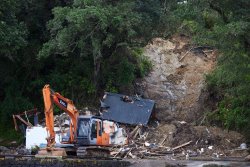Communities came together in cyclone response

February 13 marks the first anniversary of Cyclone Gabrielle.
Hard on the heels of the unprecedented flooding at the end of January 2023, Cyclone Gabrielle cut a swathe of destruction across the country – including Northland, Auckland, the Coromandel, and the Hawkes Bay – inducing the government to declare a National State of Emergency.
Tragically, the cyclone also claimed 11 lives – including volunteer firefighters Craig Stevens and Dave van Zwanenberg, who died in a landslip at Muriwai.
The devastation was unlike anything seen in our country before, and has been recorded in detail in newspapers, and on television. Landslips and debris from flooding claimed homes, roads, bridges, and more. Power, water, and telecommunications were disrupted. Entire communities were cut off – some for extended periods.
In Auckland alone, thousands were left suddenly homeless as their houses were either destroyed, or too badly damaged to return to. While some have since been repaired and re-occupied – there are still many homeowners in limbo, struggling through the many difficult layers of insurance, assessment processes, and other bureaucracy.
Communities came together in the crisis – as they always do.
The people of Auckland – and elsewhere – were quick to respond. They volunteered their time. They donated goods. They supported fundraising efforts. They rallied to provide safety and shelter to those who needed it.
Volunteers stepped in to fill the gaps that authorities were unable to cover in the face of such widespread devastation. There were tales of outright heroism – through to quiet acts of kindness that didn’t garner headlines, but meant the world to the people they helped.
Volunteering Auckland set up a dedicated website page where organisations could publicise the services and support they were able to offer, and people affected could find what they needed. Our sister organisations in Gisborne and other areas affected did the same.
The aftermath of the January flooding, then Cyclone Gabrielle, prompted discussions about how disaster-ready we are – including homes, businesses, and communities.
It was abundantly clear that it was impossible for councils, disaster response agencies, emergency services to be everywhere at once – and that it takes time for widespread power, water, wastewater, telecommunications outages to be restored, and for landslips, roads, and bridges to be repaired.
Communities would simply have to cope on their own, for as long as necessary.
A number of rural communities already had an active ‘bush telegraph’, along with a good supply of common sense and useful equipment, which meant they could rally quickly to support their neighbours.
Some areas – rural and urban – had established community civil defence groups. But most did not.
Over the past year, Auckland Council and its disaster-response department Auckland Emergency Management [AEM] faced public criticism for their response to both events – and are working on a number of changes and improvements so future responses will be quicker and better.
There is a clear need to provide strong support to community-led civil defence groups (sometimes called ‘emergency resilience/readiness/ preparedness’ groups) – both existing and new – with information, guidance, training, and money.
A number of these community civil defence groups had already developed Community Emergency Plans. These have local information such as locations of ‘community emergency hubs’ (more on those later), and useful resources in the local area, along with more general information on being emergency-ready.
AEM now has plans to gather existing Community Emergency Plans and make them all available through its website – so in the event of a disaster you can easily find a local plan, no matter where you are when the emergency hits.
The Community Emergency Hubs mentioned before would be a ‘first port of call’ when you need to get to safety. When an emergency strikes, the local civil defence volunteers would assess the scale of the event and decide whether to open any of the hubs in the area. They’re likely to be in places like community halls, schools, scout dens, church halls, and similar.
The volunteer-run Community Hubs are familiar places you can easily get to when disaster strikes. They can be used as meeting places to get information and support, and connect with official agencies. Some (though by no means all) may also be able to provide meals, overnight accommodation, or showers – and others may collect and distribute donations and other resources.
The community hubs are not formal Civil Defence Centres (CDCs) – which would be run by AEM, and would have full facililities, but which would very likely take longer to be staffed, provisioned, and opened.
Volunteers are essential to these groups - which will form an important part of future emergency responses.
HOW TO VOLUNTEER
If you’d like to volunteer for an existing community civil defence group, contact Auckland Emergency Management (AEM), who can put you in touch with the group nearest you. If there is no group in your area, and you’re keen to set one up, they can provide information and resources to assist you.
BEING EMERGENCY-READY
The Auckland Emergency Management and government Get Ready and Civil Defence websites also have information and resources on how you can prepare for a range of emergencies and disasters:
Auckland Emergency Management
P 0800 22 22 00 or 09 355 3553
www.aucklandemergencymanagement.org.nz
www.facebook.com/aklcdem
NZ Civil Defence / NZ Get Ready
www.getready.govt.nz
www.civildefence.govt.nz
www.facebook.com/NZCivilDefence
By Ruth Jackson
Volunteering Auckland Media & Marketing

